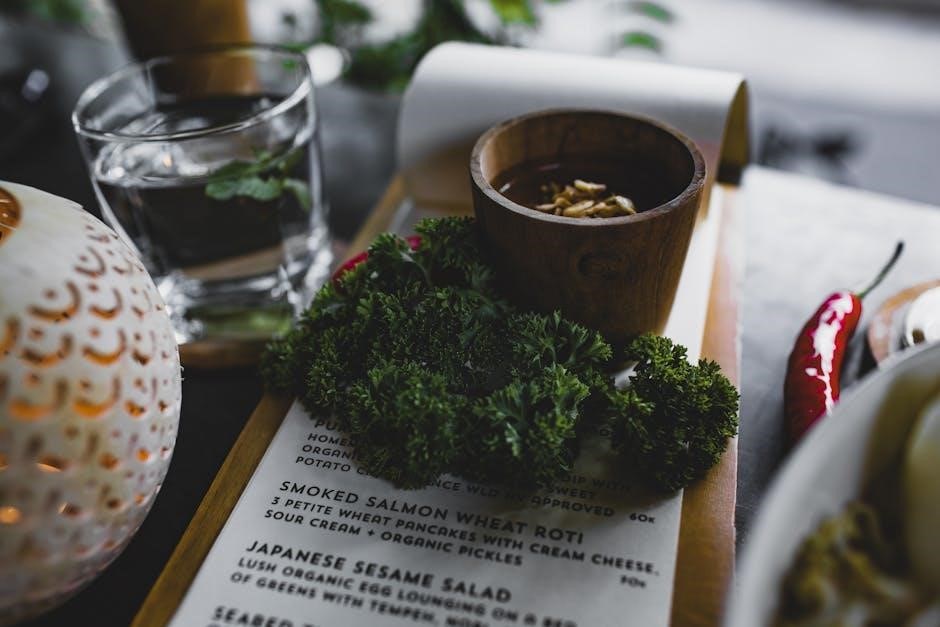Managing gout through diet is essential to reduce uric acid levels and prevent flare-ups. A printable gout food list PDF helps guide food choices, ensuring a balanced and low-purine diet for better health outcomes.
Understanding Gout and Its Connection to Diet
Gout is a form of arthritis caused by elevated uric acid levels, which can crystallize in joints, leading to pain and inflammation. Diet plays a crucial role in managing gout, as certain foods high in purines can increase uric acid production. Purines are naturally occurring substances found in various foods, and their breakdown in the body contributes to uric acid levels. A low-purine diet helps reduce the risk of gout attacks by limiting these triggers. Understanding which foods are high, moderate, or low in purines is essential for creating an effective meal plan. This knowledge enables individuals to make informed choices, helping to balance nutrition while minimizing gout symptoms.
Importance of a Low-Purine Diet in Managing Gout
A low-purine diet is crucial for managing gout, as it helps reduce uric acid levels in the body. High purine intake can lead to increased uric acid production, forming crystals that cause joint pain and inflammation. By limiting purine-rich foods, individuals can lower their risk of gout attacks and alleviate symptoms. This dietary approach is often combined with lifestyle changes and medical treatments for optimal results. Foods like red meat, seafood, and alcohol are typically high in purines, while plant-based options and low-fat dairy are safer choices. A well-planned low-purine diet not only supports gout management but also promotes overall health and well-being. It is a key component of a comprehensive gout treatment plan, aiding in long-term symptom control and improved quality of life.

Food Categories for Gout Management
Organizing foods into low, moderate, and high purine categories helps simplify dietary choices. This structured approach ensures balanced nutrition while minimizing gout flare-ups and promoting overall well-being.
- Low-Purine Foods: Safe for daily consumption.
- Moderate-Purine Foods: Limited portions advised.
- High-Purine Foods: Should be avoided to prevent gout attacks.
Low-Purine Foods: Safe Choices for Daily Consumption
Low-purine foods are ideal for daily consumption, as they minimize uric acid production and reduce gout flare-ups. These include vegetables like spinach, carrots, and celery, as well as most fruits, such as cherries, berries, and citrus. Whole grains like rice, oats, and barley are also safe choices. Low-fat dairy products, such as milk and yogurt, are recommended, along with plant-based proteins like lentils and beans. Additionally, nuts, seeds, and olive oil are healthy options. Incorporating these foods into your diet promotes balanced nutrition while keeping purine intake low. A printable gout food list PDF can help you easily identify and track these options for daily meals.
Moderate-Purine Foods: Limited Portion Sizes
Moderate-purine foods should be consumed in limited portions to manage gout effectively. These include lean meats like chicken and turkey (2-3 ounces per serving), certain fish like salmon, and plant-based options like beans and lentils. Vegetables such as asparagus, mushrooms, and peas also fall into this category. Portion control is crucial, as overconsumption can increase uric acid levels. When gout is under control, these foods can be included in small amounts, but they should be avoided during flare-ups. A printable gout food list PDF can help track these foods, ensuring portion sizes remain within recommended limits. Monitoring intake and adjusting based on individual tolerance is key to maintaining a balanced diet and preventing gout attacks.
High-Purine Foods: Avoidance for Gout Prevention
High-purine foods are a significant contributor to uric acid buildup, increasing the risk of gout attacks. These include organ meats like liver, game meats, and certain seafood such as anchovies, herring, and mackerel. Red meats like beef and pork, as well as fatty fish and seafood like tuna, shrimp, and lobster, are also high in purines. Alcohol, especially beer and spirits, should be avoided. A printable gout food list PDF can help identify and avoid these foods. Eliminating them from the diet is crucial for managing gout effectively and preventing future flare-ups. By excluding high-purine foods, individuals can better control their uric acid levels and reduce inflammation in the joints.

Creating a Printable Gout Food List PDF
A printable gout food list PDF categorizes foods into low, moderate, and high purine levels, providing clear guidance for managing gout through diet, helping users avoid triggers and reduce uric acid levels.
Steps to Design a Clear and Usable Food Chart
Creating a clear food chart involves categorizing foods into low, moderate, and high purine levels. Use tables with columns for food names, purine content, and portion guidelines. Highlight categories using colors for quick reference. Include serving sizes and define what constitutes a serving for each group. Add space for personal notes to track reactions and preferences. Ensure the chart is visually appealing and easy to read, using a clean layout that fits well on a printable page. This design helps users make informed dietary choices and manage gout effectively.

Including Serving Sizes and Portion Guidelines
Clearly defining serving sizes and portion guidelines is crucial for effective gout management. Specify standard serving sizes, such as 2-3 ounces for cooked meats or 1/2 cup for vegetables. Include portion limits for moderate and high purine foods, ensuring users understand safe intake levels. Use icons or symbols to visually differentiate categories. Provide examples, like 1 serving of fish or seafood being 3 ounces, to avoid confusion. Highlighting these details helps users adhere to their dietary plan and manage uric acid levels effectively. This clarity ensures the chart is both practical and user-friendly for daily meal planning and gout prevention.

Additional Tips for Gout Diet Success
Stay hydrated, limit alcohol, and track meals to identify triggers. Pair the printable gout food list PDF with regular exercise for better uric acid management and overall health.
Incorporating Fresh Fruits and Vegetables
Fresh fruits and vegetables are essential for a gout-friendly diet, as they are naturally low in purines and rich in antioxidants and fiber. Cherries, berries, and citrus fruits like oranges and lemons are particularly beneficial, as they may help reduce uric acid levels. Leafy greens such as spinach, kale, and broccoli are also excellent choices. Aim for at least five portions of colorful fruits and vegetables daily to promote overall health and support uric acid balance. A printable gout food list PDF can help you track these foods and ensure they are a regular part of your meals. Plant-based options are ideal, as they minimize purine intake and inflammation.
Hydration and Fluid Intake Recommendations
Staying hydrated is crucial for managing gout, as water helps flush out uric acid and reduce crystal formation. Aim for at least 8-10 glasses of fluid daily, primarily water. Herbal teas, low-fat dairy, and fresh fruit juices (without added sugar) are also beneficial. Alcohol, especially beer and spirits, should be limited or avoided, as it can raise uric acid levels. Sugary drinks, like soda, should also be minimized. A printable gout food list PDF can include a section for tracking daily fluid intake, ensuring you meet your hydration goals. Proper hydration, combined with a balanced diet, supports overall health and gout management.
A balanced diet and hydration are key to managing gout. Use a printable gout food list PDF to guide your choices and consult a healthcare professional for personalized advice.
Monitoring Progress and Adjusting the Diet Plan
Regularly tracking your diet and gout symptoms is crucial for long-term management. Use a printable gout food list PDF to monitor daily food intake and identify potential triggers. Keep a diary to record flare-ups, food consumption, and hydration levels. Schedule regular check-ups with your healthcare provider to assess uric acid levels and overall progress. Adjust your diet plan based on observed patterns, ensuring it remains balanced and effective. If certain foods consistently cause issues, consider further limiting them. Stay patient and consistent, as it may take time to notice significant improvements. A tailored approach, guided by your healthcare team, will help optimize your gout management strategy.
Consulting with Healthcare Professionals for Personalized Advice
Consulting with healthcare professionals is essential for creating a personalized gout management plan. They can review your printable gout food list PDF, ensuring it aligns with your specific needs and health goals. A dietitian or doctor can help tailor the diet plan, considering factors like weight, medical history, and other health conditions. Regular check-ups allow for monitoring of uric acid levels and adjustments to the diet plan as needed. Healthcare providers can also address concerns about nutrient deficiencies and offer strategies to maintain a balanced diet. Their expertise ensures that your gout management plan is both effective and sustainable, leading to better long-term health outcomes and fewer gout attacks.

Leave a Reply
You must be logged in to post a comment.